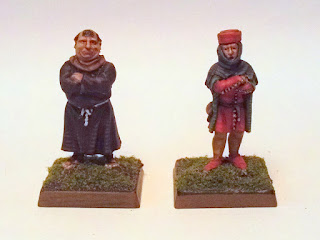I bought these Wargames Foundry figures (Code: MED 209) a few years ago at a local show intending to use them almost as terrain pieces in games but for some reason never quite got round to painting them.
 |
| Group shoot |
Sculpted by one of the Perry brothers (I'm assuming Michael as he tends to favour the medieval period) these form part of the large range of figures produced by Wargames Foundry. Although these figures are more appropriate for the High to Late Middle ages (they are from Foundry's 100 Years War range) I've be using these for both my 13th century and WoTR games.
Contrary to popular belief and Hollywood the vast majority of people didn't clothe themselves in various shades of brown or filthy raps. It is true that there were strict rules as to what you could wear according to your social status but if you look at contemporary illustrations combinations of red, blues and greens materials are often portrayed.
 |
| Ladies of various social class with the posh Lady of the manor on the right |
Black clothes were also popular but idea of the colour being jet black isn't quite appropriate, with various shades of grey probably being more accurate description. What we today would consider true black was a difficult and expensive colour to achieve due to repeated dying process required to produce it. It is probably also this reason you occasionally see it chosen as livery colours by such wealthy people as the Duke of Buckingham for example. It was a deliberate display of wealth and would have indicated the wearer was a person of note or was employed by someone who was. It would have been immediately obvious to someone of the period to identify the class of a person by their choice of clothes and the colours they wore.
This, to a certain degree, still remains the case today whether we realise it or not. Most people will have preconceptions upon seeing someone dressed in a shell suit, baseball cap and trainers just as they will seeing a person wearing a tweed jacket, flat cap, corduroy trousers and Hunter Wellingtons.
 |
| Working types - front view |
 |
| Working types - rear view |
There is a direct connection to Dudley illustrated in the Psalter but I'll detail this in another post.



































